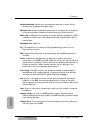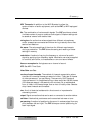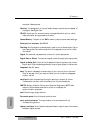
Glossary
DA7 Users’ Guide
Glossary
Glossary-5
Equalizer library. Predefined commonly used equalizer settings that can be
recalled. The DA7 allows the creation of custom settings that can be saved
and recalled.
equalization. The adjustment of the frequency response of an audio signal.
See Equalizer.
EPROM Electrically Progamable Read Only Memory. A intergrated circuit
memory chip that can store the instructions or programs needed to
operate digital equipment. The DA7 has two EPROM’s which store the
operating system for the mixer. The information stored on EPROM’s is
also known as firmware and eliminates the need for software stored on
floppy or hard disks.
expander. A process that expands the dynamic range of an audio signal. The
DA7 has a fully controllable internal expander on each input as part of
the dynamics processor.
fader. The slide control for adjusting audio signal levels.
filter. A device to remove certain bands of frequencies. The three types of
common filters are: a low pass filter -passes only low frequency signals,
high pass -passes only high frequncy signals, band pass filters -passes only
a certain band frequncy signals. See Equalizer.
frequency. The characteristic of sound or an audio signal that determines
pitch, measured in Hertz (Hz). The DA7’s equalizer has controls that vary
the center frequency of four separate filters.
gain. An increase in the level of audio signal, measured in decibels (Db) or
volume units (vu). Gain controls on the DA7 are used to adjust signal
levels for optimal performance.
gate. A method of suppressing audio signals below a predetermined level.
Gates are used to suppress unwanted low level noise. The DA7 has a gate
for every fader that allows signal processing.
ground. Also known as earth ground, is the electrical connections of
equipment to the earth. By convention, earth ground is considered the 0
(zero) volt reference for electrical power. Equipment that does not have
an earth ground is a potential source of dangerous electrical shock.


















